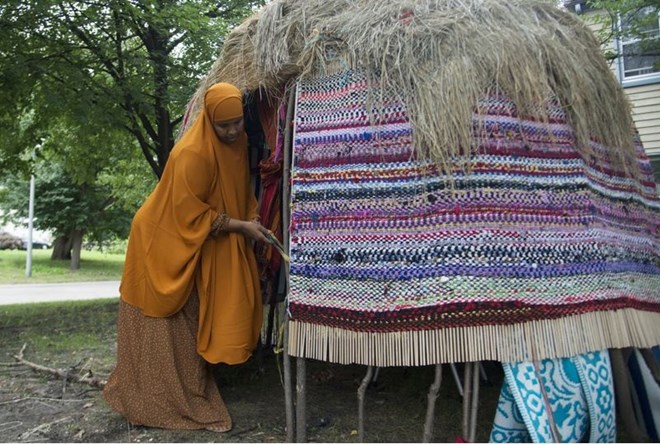Mn Daily
Tuesday October 2, 2018

The handmade house, which has been the epicenter of celebrations and weekly meetings for community members, will soon close for the winter.
After feeling alone and unsafe during her early months in Cedar-Riverside, Ayan Isaq decided to find a way to bring her community together.
Her idea spurred local Somali women to create a traditional Somali house held together by sticks, grass and old clothing.
Completed in the spring, the house has been at the center of everything from holiday celebrations to weekly tea. Located at the intersection of 19th and 6th Avenue South, the intricately woven colors stand out from the surrounding single-family homes.
“This is about the neighborhood [communicating and seeing] each other, and safety,” said Isaq, community liaison for the nonprofit developer West Bank Community Development Corporation.
The WBCDC provides resources to the women as part of its outreach to the Somali community, which has been ongoing sporadically for a decade, said program manager Debbie Wolking. This the first time the developer has seen a comprehensive project within the Somali community get off the ground.
The house fosters a sense of companionship and security among the women, who can bring their children outside under the watchful eye of the community, Isaq said.
“Unless you know your neighbor, you don't know what’s going on with them. It’s good to come out and have a cup of tea or have a bottle of water together and share. It makes [a] big difference,” said Isaq.
Gathering materials is a community effort. Old cloth is donated by residents for weaving. The women gather sticks by the Mississippi River on their weekly walks. But the smaller sticks and grass are harder to find in Minnesota, so WBCDC orders those on Amazon.
In Somalia, similar houses are common, said Isaq. But having left her home country at an early age due to the civil war, Isaq said her main experiences with these structures were in refugee camps. She and the other women relied on the expertise of their neighbor Fatuma Halki.
“I never forgot because I like it,” said Halki, who learned to build traditional Somali houses when she was 14 years old.
The house has been an intersection for both the Somali and native-born residents to meet. Somali residents recognize it from their country, while Americans stop and learn about the culture, Halki said. She hopes the younger Somali-Americans will learn to recreate the house and keep the tradition alive.
While the house will be bundled away for storage in October, Halki is already looking ahead to next year.
“I would like to build [it] more beautiful in the summer,” said Halki.
The houses were a sign of endurance and adaptability in the refugee camps for Isaq. In the camps, the refugees were only given tarps and told to build their own shelter. Isaq said she would like to teach those living at the homeless encampment at Hiawatha Avenue and East Franklin Avenue how to construct similar houses, but she doesn’t think the City of Minneapolis will allow it.
Two-year Cedar-Riverside resident Laura Andre’s perception of the neighborhood has changed since she was a University of Minnesota student. Andre, who visits the house with her two daughters, said increased security and friendly neighbors makes the area a welcoming place for her family.
“I really believe that who your neighbors are can affect your view of the world and can really help you become familiar with someone who looks different from you,” said Andre. “I hope with my daughters growing up with different kinds of people, that will be the inclination.”